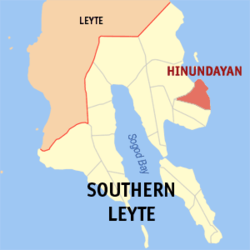Hinundayan | |
|---|---|
| Municipality of Hinundayan | |
| Motto: "Hinundayan can do!" | |
 Map of Southern Leyte with Hinundayan highlighted | |
Location within the Philippines | |
| Coordinates: 10°21′N125°15′E / 10.35°N 125.25°E | |
| Country | Philippines |
| Region | Eastern Visayas |
| Province | Southern Leyte |
| District | 2nd district |
| Founded | March 21, 1876 |
| Barangays | 17 (see Barangays) |
| Government | |
| • Type | Sangguniang Bayan |
| • Mayor | Evelyn T. Lee (NUP) |
| • Vice Mayor | Edna A. Resma (NUP) |
| • Representative | Christopherson Yap |
| • Municipal Council | Members |
| • Electorate | 10,122 voters (2025) |
| Area | |
• Total | 59.90 km2 (23.13 sq mi) |
| Elevation | 46 m (151 ft) |
| Highest elevation | 519 m (1,703 ft) |
| Lowest elevation | −1 m (−3 ft) |
| Population (2024 census) [3] | |
• Total | 13,042 |
| • Density | 220/km2 (560/sq mi) |
| • Households | 3,402 |
| Economy | |
| • Income class | 5th municipal income class |
| • Poverty incidence | 21.66 |
| • Revenue | ₱ 111.4 million (2022) |
| • Assets | ₱ 275.2 million (2022) |
| • Expenditure | ₱ 79.17 million (2022) |
| Service provider | |
| • Electricity | Southern Leyte Electric Cooperative (SOLECO) |
| Time zone | UTC+8 (PST) |
| ZIP code | 6609 |
| PSGC | |
| IDD : area code | +63 (0)53 |
| Native languages | Boholano dialect Cebuano Tagalog |
| Website | www |
Hinundayan, officially the Municipality of Hinundayan (Kabalian: Lungsod san Hinundayan; Cebuano : Lungsod sa Hinundayan; Tagalog : Bayan ng Hinundayan), is a municipality in the province of Southern Leyte, Philippines. According to the Hinundayan has a total land area of 6,108 hectares or 61.08 square kilometers, comprising 17 barangays. 2020 census, it has a population of 12,398 people. [5]


